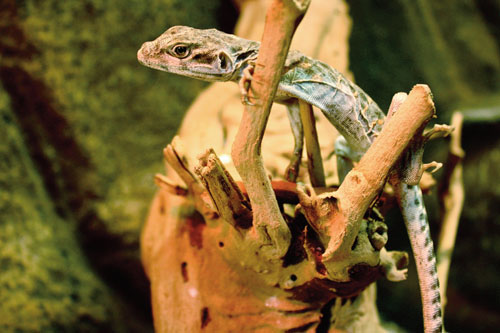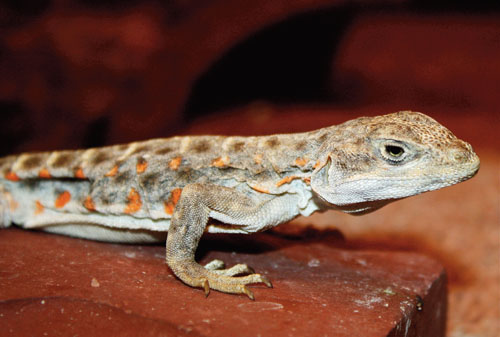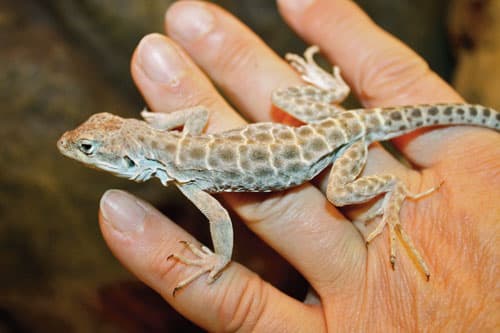Gambelia wislizenii are among the underrated reptile species native to the United States.
 |
They leap, they pounce, they bite and they have conspicuous spots. They are the leopards of the American west, and they are not mammalian megafauna but saurian micropredators. They are the leopard lizards (Gambelia wislizenii), and their name is quite appropriate. Unlike the leopard geckos of southern Asia, named solely for the spotted pattern of non-hybrid adults, American leopard lizards deserve their name for both their pattern and their feeding behavior.
Leopard lizards are among the underrated reptile species native to the United States. As many of the more experienced herpetoculturists know, America has many appropriate lizard species that make hardy and beautiful terrarium residents, including collared lizards, desert iguanas, chuckwallas and leopard lizards. Few people actively breed these species, however, so availability is largely dependent upon seasonally wild-caught specimens. This need not be the case because all of the named species can readily be bred in captivity.

Photo credit: Robert George
Although found in arroyos and washes, leopard lizards will stay away from parts of those areas that restrict their field of vision.
Know Your Leopards
Three species of very similar-looking leopard lizards are known from the western United States, Baja California and extreme northwestern Mexico. Most widespread, and thus likely to become a terrarium animal, is the long-nosed leopard lizard (Gambelia wislizenii). The very similar, but darker-colored, Mexican leopard lizard (G. copei), also called Cope's leopard lizard, occurs throughout much of Baja California and enters the United States only marginally around Cameron Corners, Campo and the Potrero Grande of southern California. Because of its restricted U.S. range and the severe restrictions on importing animals from Mexico, Cope's leopard lizard is, for now, unlikely to be encountered by herpetoculturists. The third species is the critically endangered blunt-nosed leopard lizard (G. silus) of California's central San Joaquin Valley. It is readily distinguished from the other two species in that males, rather than females, sport orange or reddish ventral coloring and breeding markings, and it has a distinctly shortened snout (silus means "pug-nosed"). This lizard's specialized habitat has been largely converted to agricultural purposes, and conservation efforts and laws have made the species unavailable for collecting or commercial trade.
Leopard Lizard Names
Leopard lizards bear three patronyms that have interesting historical significance. Baird and Girard, when describing the new species, wrote, "The specimen, we have figured, was caught near Santa Fe by Dr. Wislizenius during the Mexican war. To him, we take great pleasure in dedicating it, in testimonial of his zeal for science, during the arduous duties of an army surgeon, while attached to Colonel Doniphan's command." Frederick Adolph Wislizenius, M.D. (1810-1889), was briefly attached as a surgeon with a U.S. Army detachment during the Mexican-American War and collected specimens, often at considerable risk, as a personal activity. The genus name, Gambelia, was given in recognition of another doctor/explorer, William Gambel, M.D. (1823-1849), who amassed several large collections of plants and animals throughout North America. Edward Drinker Cope (1840-1897) was a giant in the fields of herpetology, ichthyology, and paleontology, best known for his part in the "Bone Wars" that brought dinosaurs to the attention of the public. He published more than one thousand papers and described scores of new genera and species, mostly of North American vertebrates. The scholarly journal Copeia was named in his honor.
A description of the long-nosed leopard lizard applies, with minor variation, to all three taxa. The snout is relatively long and somewhat depressed. The temples are robust, containing powerful jaw muscles. There are functional eyelids and distinct ear openings. The body is also somewhat depressed and the limbs are long and strong. The tail is longer than the head and body length combined, and it is cylindrical. Autotomy – the ability to lose the tail to a predator – is possible, but a lost tail will not regrow; these lizards are not quick to drop the useful appendage. Coloring is variable and provides excellent camouflage with the local substrate. The dorsal coloring is some shade of brown or gray-brown, with numerous dark spots, bars (mainly along the back) or a combination of both. Young have distinct, cream-colored crossbars, which may fade or completely disappear in adults. The lower surfaces tend to be white or very light tan. In G. copei and G. wislezenii females, the underside of the tail is orange or coral pink, while in males and young, it is the same color as the belly. During the breeding season, females develop small, light-orange spots on the flanks, which become larger and more intense after mating.
Adults may reach a snout-to-vent length of about 5 inches, with females attaining a larger size, up to 7 percent, than males. Unlike many related species, leopard lizards are not territorial, and males may be safely housed together in a single terrarium.
Leopard lizards are primarily residents of flat deserts, where considerable plant cover, typically shrubs, are present. Favored terrain includes creosote, mesquite and other sparse, low vegetation. They are usually absent from grassy areas or places where brush or trees are dense. Although found in arroyos and washes, leopard lizards will stay away from parts of those areas that restrict their field of vision. They are found on any type of sandy soil and seem particularly common on harder, pebbled soils. Most lizards are active from sunrise until noon, and except on the hottest days, again in the late afternoon.
Their response to a threat will be based largely on the lizard's temperature at the time. If it is hot, they are capable of rapid running for a considerable distance, but if they are cooler, they are more likely to make a swift, short dash from a threat and then lay flat and still, using their excellent coloration to act as camouflage. If handled, they are very prone to bite, and the jaws are strong enough that a bite may break the skin. They are active from late April through mid-August. Leopard lizard life span is 5 to 7 years.
Habitat Requirements
Although adult leopard lizards are much smaller than the more-popular Australian bearded dragons, they still need a comparatively large enclosure. This is because leopard lizards are active foragers rather than sit-and-wait ambushers. They tend to be active much of the day. I suggest enclosure dimensions that are at least 36 inches long, 24 inches wide and 28 inches tall for one lizard. Leopard lizards can leap incredibly high, so unless the 28-inch-tall terrarium has a secure lid, the lizards could easily escape. I recently measured the jumping prowess of some adults. From a standing start, they easily leapt as far as 30 inches and as high as 28 inches. Given a running start, both measures are significantly larger.
The terrarium must be provided with light and heat sources to maintain the high ambient temperatures these lizards need. Daytime ambient temperature should be above 85 degrees Fahrenheit, and the lizards may be active at temperatures up to 105 degrees. During the most intense heat of the day, however, they are most likely to be concealed in cooler, shady places. Preferred retreats are burrows that extend under low desert shrubs. In the southern portions of their range, there is little annual temperature fluctuation, but the difference between daytime highs and nighttime lows can be considerable. For more northerly locations, including Utah, Oregon and Idaho, winters can be extremely cold and accompanied by snow. In such places, leopard lizards retreat in the late fall and overwinter in deep burrows. In neither place are they likely to emerge unless temperatures remain above 82 degrees for several days. Full-spectrum, ultraviolet lighting should also be provided during the same hours regular lighting is in use.
The terrarium should contain 8 to 12 inches of very slightly moistened sand to provide adequate substrate for the lizards to dig their own retreats. If housed with other desert species, such as chuckwallas or desert iguanas, burrows may be shared. Include branches, bits of cholla (Opuntia) cactus or creosote, if possible, which will be used for shade. The terrarium may also contain live plants, such as desert grasses and prickly pear cactus, largely for aesthetic decoration.
Diet
Here is another reason, besides the spots, for the leopard lizard's common name. All are powerful hunters. Their diet, particularly those from the southern portions of their range, is made up largely of other, smaller lizards. This includes species such as side-blotched lizards (Uta stansburiana) and the young of larger species. Therefore, do not house leopard lizards with smaller lizards, even of their own species. Also included in their diet are pinky-sized rodents and a large variety of insects, including grasshoppers, crickets, flies, butterflies, bees, yellow-jackets, termites, ants and centipedes. A study by Lappin and German (2005) involved feeding leopard lizards harmless crickets or stinging bees or yellow-jackets. The lizards recognized the differences in the prey and adapted their capture approach accordingly.

Photo credit: Robert George
The lifespan of the leopard gecko is around 5 to 7 years.
Upon spying a smaller lizard, for example, the leopard lizard may make short bursts toward the prey before a final dash to seize it. Vertebrates are caught by the nape and violently shaken until stunned or dead, and then consumed head first. Gambelia are also capable of stalking larger prey species. On rare occasions, a leopard lizard will grab more than it can swallow and either disgorge the prey or suffocate.
Because of the vertebrate component of their diet in the wild, leopard lizards will probably need calcium supplementation in captivity. This is best achieved by gut loading crickets and mealworms for two to three days prior to feeding them to the lizards. Even if you offer smaller lizards as food items (unless doing so several times per week), you still may not be providing adequate calcium. Leopard lizards will often take pink mice, but these will not contain the calcium levels needed to compensate for the bones found in adult lizards. Leopard lizards should be fed daily, and if more than one is in the terrarium, be sure that each lizard eats. These lizards are very aggressive at feeding time. They will take water from a dish or from droplets on terrarium fixtures, but they tend to get all the water they need from a proper diet of prey animals.
Breeding Leopards
Leopard lizards are rarely bred in captivity, but getting them to breed is not especially difficult. Mating occurs between late April and mid-May, after which females will develop pronounced coral or reddish spots on the flanks and belly. After mating, females remain active and will feed on their regular schedule. They will also become progressively more aggressive toward males as the egg-laying date approaches. In the days prior to laying, expect the females to spend more time basking under the hotspot, and digging several test nests. After laying, females will be noticeably thinner, with loose lateral skin. They may delay feeding again for two to four days.
Eggs are laid between May and late June. Up to 11 eggs are deposited in a burrow and hatch in 35 to 50 days. Young lizards are dark tan to brown, with very conspicuous light crossbands, and measure about 1 to 1.15 inches snout to vent. Hatchlings will begin feeding on small insects a few days after emerging, and they put on considerable bulk before winter dormancy sets in. Feed them daily, as much as they will consume, providing small gut-loaded insects. They take on adult coloring by the middle of their first summer and become sexually mature during the second.
Female Breeding Coloration
It was long hypothesized that, as in other iguanine lizards, the female breeding coloration in leopard lizards is apparently a signal to males that they are too late to mate with a female. However, in 2004, Kamelia Fallahpour tested that model for her master's degree research and found that "female breeding coloration may not be a signal to males in leopard lizards. Apparently, the relevance of this signal to males has been lost, perhaps because males are not territorial in this species, unlike most other crotaphytids. Moreover, the cost of the signal may be low for females because they generally seek shelter under shrubs, which conceals the coloration."
Winter Care
The normal period of activity for leopard lizards is mid-April through mid-August, just four months during the Northern Hemisphere's summer. Therefore, eight months are spent in a dormant condition. The potential breeder might want to duplicate this seasonal variation. In the wild, leopard lizards become scarce when temperatures duck below 80 degrees, and they tend to remain concealed once they reach 78 degrees. If the lizards are to remain in their terrarium, there must be sand of adequate depth for them to dig secure burrows. Periods of available light should be gradually reduced over 10 to 14 days, starting by eliminating ultraviolet lighting. Use lower-wattage bulbs or fewer heat sources so daytime temperatures gradually decline to less than 60 degrees Fahrenheit. Once lizards retreat to their burrows, no lighting need be provided until the simulated spring awakening. Unless, for some reason, your house is subject to internal frost, the lizards should require no special care while dormant; burrow depth usually coincides with how deep the soil frost line goes, which inside a house should be irrelevant. During dormancy, leopard lizards will neither eat nor drink, but when they emerge in spring, they will be ravenous.
To revitalize lizards, begin cycling the heat lamps, initially for six hours and increasing to 10 to 12 hours within a week. Once lizards emerge, begin use of the UV lighting, too. Feed lizards on the second day of activity, and be prepared to offer larger-than-usual amounts of food items. A beastie can get pretty hungry after eight months of sleep! Mating activity should begin about two weeks after spring.
One potential consequence to keep in mind if not over-wintering the lizards: Does year-round activity reduce life span? I have found no useful data on this subject, but propose that being fully active year round – in essence, making four years out of one – may have longevity and fertility consequences. This would be a good research project for breeders. Just keep me posted! REPTILES
Robert George Sprackland, Ph.D., is a herpetologist who has spent more than 40 years studying the systematics, evolution and zoogeography of lizards. His books include the recently published "Giant Lizards: The Definitive Guide to the Natural History, Care, and Breeding of Monitors, Iguanas, and Other Large Lizards" (2009) and "The Pocket Expert Guide to Lizards: 300+ Essential Species," both by TFH, Inc. He has been a regular contributor to REPTILES since its inception. Contact him at emporiumofextinctexotica.webs.com or http://robertsprackland.webs.com.


